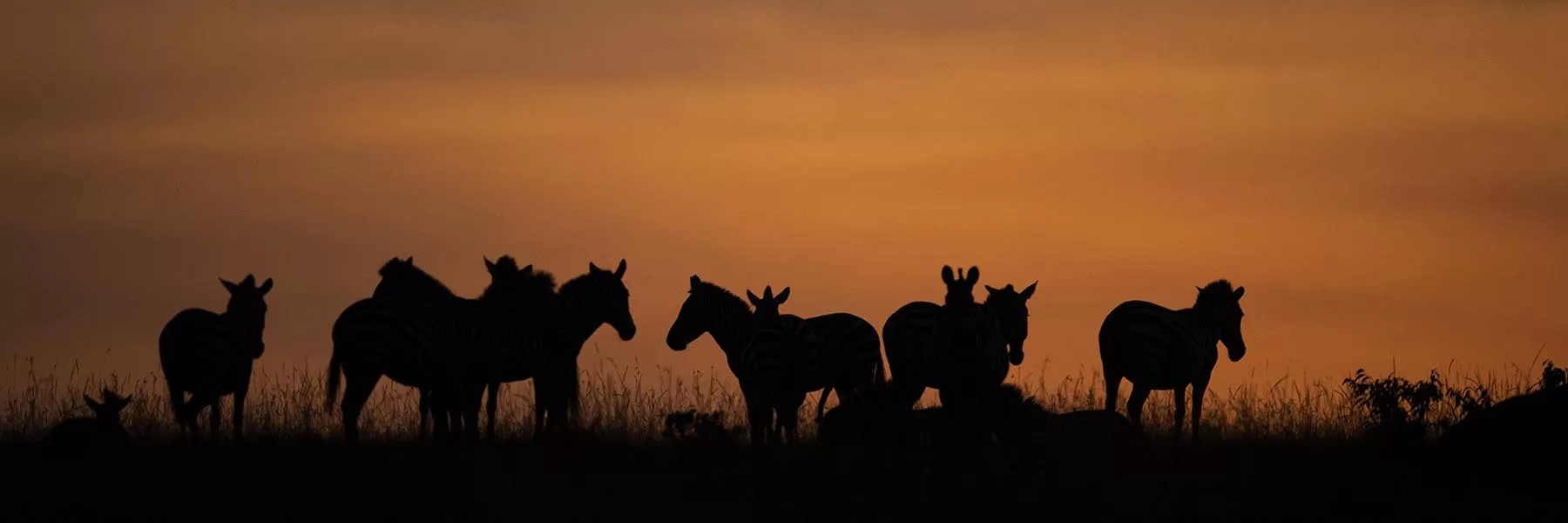Masai Mara is home to one of the finest wildlife collections in the world. The sprawling landscape, dense forests, open grasslands, and flowing rivers provide a great habitat for more than 90 mammalian species to thrive. The top mammal species that can be spotted in Masai Mara are:
The Big Five
Masai Mara is one of the few places in Africa where there’s a very good chance of spotting all the Big-5 animals.
- Lion: Masai Mara is home to between 800 to 900 lions. These ferocious predators, with their size and agility, are easily spotted here, resting in the tall grass, stalking the plains, or even during a hunt. There are many lion prides, consisting of 3 to 20 individuals here. Some of the famous prides are the Marsh pride, Topi pride, Enkoyonai Pride, Kicheche Pride etc.
- Elephant: One of the largest land animals on Earth, elephants are social, intelligent, and familial mammals. These majestic mammals have dwindled in number in recent years because of rampant poaching. However, their numbers have recently improved thanks to local conservation efforts, and there’s a very high probability of spotting them in Masai Mara.
- Rhinoceros: Only Black Rhinos reside in Masai Mara, and their counterparts, the White Rhinos are found at Lake Nakuru. Black Rhinos and smaller and more aggressive of the two. Out of the Big five animals, spotting a rhino in Masai Mara is the most difficult, seeing as only 30-40 individuals are left because of poaching.
- Leopard: Even though spotting a leopard in Masai Mara isn’t difficult, these graceful mammals are still considered as endangered. These elusive nocturnal creatures love rocks and woodlands. Unlike lions, leopards prefer a solitary life, away from other animals. Some of the famous Leopards are Bahati, Koboso, Bella, Half Tail
- African Buffalo: These territorial and aggressive animals are considered the most dangerous animals in East Africa. Buffalos are often found in herds of 100 or more individuals, mostly close to water sources, and are often spotted grazing the floodplains.
Animals of the great migration
In search of green pastures filled with blades of grass, some animals of Africa make their yearly pilgrimage from the plains of Masai Mara to Serengeti National Park. This spectacle, consisting of more than a million individual animals, is one of the greatest in nature.
- Wildebeest: These antelopes are herd animals and are active round the clock, traveling and grazing through the lands. It is easy to spot these creatures in Masai Mara, especially from July to October considering more than a million of them roam the lands.
- Zebra: These animals, belonging to the horse family, are present in Masai Mara in large numbers. These herd animals are often seen grazing the grass together or even grooming each other. These mammals accompany the wildebeest during the great migration. Around 200,000 of these animals can be found all over Masai Mara.
- Thomson’s Gazelle: These animals prefer grasslands and savannahs. You can spot them easily in Masai Mara, especially during the great migration, when upwards of 500,000 of these animals make the journey.
Other animals
- Cheetah: The fastest land animals in the world are easily spotted in Masai Mara, often involved in their main preoccupation- hunting. It is an amazing sight to witness a cheetah stalking its prey and then charge towards it to make the kill. Despite their density being high in Masai Mara, cheetahs are included in the endangered animals’ list, owing to their dwindling numbers.
- Giraffe: The world’s tallest mammals are known for their graceful movements, visible even when they run at speeds as high as 60 kilometres an hour. Their elongated necks help these herbivores reach plants and branches that are inaccessible to other animals. Around 2500 of these unique animals can be found in Masai Mara.
- Hippo: With male hippos weighing as much as 1.5 tonnes, these are the third-largest land mammals. Hippos are semi-aquatic creatures and can be seen near swamps, lakes, and rivers. Although they stay close to each other when they rest in the water, they prefer to graze alone.
- Antelope: Antelopes are quite common in Masai Mara and you can easily spot them in large numbers, usually near arid regions with scrub or bush covers. There are different types of antelopes- Dwarf Antelopes like Oribi, Dik-Dik, and Klipspringer, Horse Antelopes like Topi, Hartebeest, and white-bearded wildebeest, and Spiral-horned antelopes like Bushbuck and Common Eland.
- Honey Badgers: These mammals are known for their fondness of honey and honeybee larvae. They also feed on reptiles, insects, birds, and amphibians. Their acute sense of smell helps them locate their prey. Notorious for their fearless personality, honey badgers can sometimes be seen attacking animals many times their size.
- Mongoose: Many different subspecies of Mongoose find their home in Masai Mara. Banded Mongoose is common to central and eastern Africa and like open grasslands, forests, and savannahs. Dwarf mongoose is smaller in size and feeds on insects like grasshoppers, crickets, scorpions, and spiders. Slender Mongoose is short-legged and long-bodied, and quite common in sub-Saharan Africa. It feeds on insects, reptiles, rodents, and birds.
MASAI MARA MAMMAL CHECKLIST
Here is a comprehensive check-list below of the Mammals found in the Mara.
SWINE
Warthog – Phacochoerus africanus
GIRAFFE
Masai Giraffe – Giraffe camelopardalis tippelskirchi
HIPPOPOTAMUSES
Common Hippopotamus – Hippopotamus amphibius
DWARF ANTELOPES
Kirk’s Dik-Dik – Madoqua kirkii
Klipspringer – Oreotragus oreotragus
Oribi – Ourebia ourebi
GAZELLES
Thomson’s Gazelle – Gazella thomsonii
Grant’s Gazelle – Gazella granti
REEDBUCKS AND KOBS
Common Reedbuck – Redunca arundinum
Defassa Waterbuck – Kobus ellipsiprymnus defassa
HORSE ANTELOPES
Coke’s Hartebeest – Alcelaphus buselaphus cokii
Topi – Damaliscus lunatus jimela
White-bearded Wildebeest – Connochaetes taurinus
IMPALA
Impala – Aepyceros melampus
SPIRAL-HORNED ANTELOPES
Bushbuck – Tragelaphus scriptus
Common Eland – Tragelaphus (Taurotragus) oryx
WILD CATTLE
African Buffalo – Syncerus caffer
RHINOCEROSES
Black Rhinoceros – Diceros bicornis
ZEBRAS AND ASSES
Common Zebra – Equus burchellii
ELEPHANTS
African Elephant – Loxodonta africana
HYRAXES
Bush Hyrax – Heterohyrax brucei
AARDVARK
Aardvark – Orycteropus afer
PANGOLINS
Cape Pangolin – Manis temminckii
GENETS AND CIVETS
Common Genet – Genetta genetta
MONGOOSES
Slender Mongoose – Herpestes sanguineus
Egyptian Mongoose – Herpestes ichneumon
Marsh Mongoose – Atilax paludinosus
White-tailed Mongoose – Ichneumia albicauda
Dwarf Mongoose – Helpgale parvula
Banded Mongoose – Mungos mungo
HYENAS
Spotted Hyena – Hyaena hyaena
Aardwolf – Proteles cristatus
CATS
African Wildcat – Felis libyca
Serval – Felis (Leptaillurus) serval
Caracal – Felis (Caracal) caracal
Leopard – Panthera pardus
Lion – Panthera leo
Cheetah – Acinonyx jubatus
FOXES, JACKALS AND DOGS
Bat-eared Fox – Otocyon magalotis
Black-backed Jackal – Canis mesomelas
Side-striped Jackal – Canis adustus
African Wild Dog – Lycaon pictus
WEASELS
Striped Polecat / Zorilla – Ictonyx striatus
Honey Badger / Ratel – Mellivora capensis
BUSHBABIES
Lesser Bushbaby – Galago senegalensis
MONKEYS AND BABOONS
Syke’s Monkey / Blue Monkey – Cercopithecus mitis
Copper-tailed Monkey / Red-tailed Monkey – Cercopithecus ascanius
Vervet Monkey – Cercopithecus aethiops
Olive Baboon – Papio cynocephalus anubis
BATS
Straw-colored Fruit Bat – Eidolon helvum
Yellow-winged Bat – Eidolon helvum
HARES AND RABBITS
African Hare – Lepus capensis
SQUIRRELS
Kenyan Tree Squirrel – Paraxerus ochraceus
SPRINGHARE
Springhare – Pedetes capensis
OLD WORLD PORCUPINE
Southern African Crested Porcupine – Hystrix africaeaustralis
RATS AND MICE
Four-striped Grass Mouse – Rhabdomys pumilio
Savanna Giant Pouched Rat – Cricetomys gambianus
Greater Cane Rat – Thryonomys swinderianus
If you loved reading this story, then subscribe to our blog here (it will ask to verify your email) to get inspiring travel stories and trivia delivered to your email. Stories about wildlife trivia, cultural experiences, curated luxury hotel lists, underrated places to travel, polar journeys and much more.











